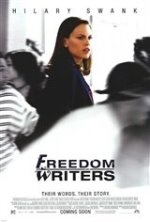Movie Review: Freedom Writers
Why?
Our assignment was to critically analyze a film’s treatment of various education issues affecting American schools and the field of education, with an emphasis on the teacher. This particular analysis will consider the film Freedom Writers, a 2007 film starring Hilary Swank as Erin Gruwell. The general premise of the film is that Ms. Gruwell, as a new teacher, holds a stereotypical view of education, and is given a class of students deemed “unteachable” by the school’s administrators. As such, Ms. Gruwell goes on an effort to “save” the students, even at the risk of her own marriage. Ultimately, the teacher and students remain together for all four years of their high school career, even publishing a book of their journals toward the end of their sophomore year. This analysis will consider the roles of teachers, students, issues of schooling, and curricula as relates to various theories of education and class discussions to date.
Critical Analysis
The filmmaker appears to address several education-related main ideas or themes in the film appear to revolve around many issues – these include banking education depicted through the stereotypical role of new teachers and curriculum violence and administrative issues, and micro-aggressions shown through issues of segregation and racism. This was an underlying premise as Gruwell joined Woodrow Wilson High School a year or two after going through a “voluntary” integration program which saw the higher achieving students leave shortly after. The issue of segregation and bigotry was highlighted not only with the student’s “self-segregation” in their class and the school’s quad. At one point she reorganizes everyone in the classroom and asks, “is everyone happy with their new borders?” Her point is further highlighted as she recognizes the “self-segregation” after walking into the quad shortly following an epiphany of “wokeness.”
At some point in a student’s life, there’s a quandary of, “what is the purpose of school?” Each begins to feel like a pawn being shoved about on a chessboard. Such is the feeling because some students believe education is all about “some person,” usually the teacher, is trying to teach them some useless content without knowing anything about them or having experienced anything in their world to really understand if what they’re learning is relevant. Students espousing such a view challenge those who represent Paulo Freire’s theory of “banking education” – that is they believe that students are to sit and take in the knowledge bestowed upon them. This theory seems to be represented by the junior and senior English teacher. Gruwell represents teachers who want to go beyond the status quo and expose students to experiences beyond their respective neighborhoods. The filmmaker seems to focus on the effort to show there are some teachers who teach for the love of teaching and, therefore, inspire their students’ desire of and interest in a “good” education.
Gruwell assigns relevant reading content and engages the students in journaling their experiences. In so doing, she seems to be working to dismantle the curriculum violence evidenced in the school. Considering none of the students knew of the Holocaust, Gruwell decides to expose the students to new experiences and place them in a situation where they become more relevant to their lived experiences. She even attempts to tackle stereotypes and administrative issues when she attempts to convince her department head to allow the students to use the brand-new books collecting dust in the book storage room, but it was to no avail. This theme was evidenced throughout the movie and is represented in the role of the department head, who also presumes low achieving students deserve to use less than ideal supplies, so they do not destroy them. Gruwell’s character represents anyone who has ever worked to fight “the system.”
Stereotyping and racism or bigotry are all through the film. Such as Wilson’s effort at “voluntary” integration appears to be the attempt of a system recognizing and working to abate institutional racism. Then there’s the soliloquy by the student Eva who scolds Gruwell for being an idealistic white teacher who espouses the stereotypical attitude of idealism and presumptions of white people and the harm such brings to people of color.
It was interesting to note the filmmaker also used music to subliminally underscore certain points in the movie. His music of choice was what’s now referred to as urban, R&B, or HipHop. There were artists such as Tupac, Gangastarr, and Common. One song of interest the filmmaker seems to use to deliver Gruwell’s recognition of the students’ self-segregation was the song Good Mourning by Talib Kweli & Hi Tek with the lyrics “wake up, wake up” playing as she perused the school’s quad viewing the varied racial groups. Then there was an inspirational portion when Montel Jordan’s “This is how we do it” plays as the students begin to raise funds to bring in the woman who sheltered Anne Frank’s family. Music was likely the vehicle of choice because most who would have viewed the film at the time would have been listeners of the same type of music used in the film.
When thinking of curriculum violence, banking education or segregation as relates to curriculum and teaching, one has to think of the lack of representation of teachers of color – or specifically, black teachers. What is the impact of the lack of a relevant curriculum for students of color? Why is there a lack of African American lawyers, doctors, or pharmacists? What does the lack of African American lawyers, doctors, and pharmacists” say about our education system or a people’s zeal for education?
When thinking through a teacher’s influence on students, it seems apropos to discuss the impact of social capital. Having spent time in the classroom as a short and long-term substitute it seems some teachers focus on a child’s future beyond their classroom; however, their thoughts do seem to differ from that of the students. It is quite possible the student’s perception of a teacher’s social capital determines the level of influence on their (i.e., the student’s) life. French sociologist Pierre Bourdieu first introduced the concept of social capital in his writing, Le Capital Social: Notes Provisories,” Actes de la Recherche in Sciences Sociales (1980). Though Bourdieu introduced the term, according to author Marion Orr, it became a widely used concept based on Robert Putnam’s usage in his book, Making Democracy Work: Civic Traditions in Modern Italy. Putnam defined “social capital as ‘features of social organization, such as trust, norms, and networks, that can improve the efficiency by facilitating coordinating actions’ ” (1993). In the end, having social capital means the reverence of such a teacher would have the ability to sway a student’s decision in just a few words.
One might presume a student’s interaction with a professional, might be influential, whether this is the teacher, doctor, lawyer or pharmacist. It is possible the daily interaction with a teacher, will have more influence, but how does this interaction ultimately encourage students? This film might suggest its necessary to better understand societal insolences regarding educating and preparing low-income students or students of color. Having teachers who are more representative of the students being taught might go a long way at influencing student choices regarding their post-secondary career or academic choices and maybe any student exposed to a racialized environment is less likely to select a college or professional career path. Perhaps unearthing and sharing stories similar to the success of the Freedom Writers was the filmmaker’s way of providing evidence of why students should consider professional careers where there is an underrepresentation of their race.
Overall the film seemed to present a well-informed perspective of urban teachers, students and the American education system at the time. The filmmaker seemed focused on ensuring viewers walked away believing everyone can play a role in inspiring our next generation or changing the education system that may be “rigged” against some. Once upon a time, the United States of America was known as “the Great Melting Pot.” To the extent that in 1977 Schoolhouse Rock created a memorable tune called “The Great American Melting Pot” – https://www.youtube.com/watch?v=5ZQl6XBo64M (TV Über, 1977, 3:20). A portion of the lyrics state, “You simply melt right in, it doesn’t matter what your skin” (TV Über, :67). Such a statement would seem to promote the mindset of everyone being the same or there being no difference between any two of us – Americans, that is. Such a belief neglects to recognize or consider the differences which make each of us unique. History will show the United States of America has always had representation from various groups of immigrants.
The “The Great American Melting Pot” also states, “America was founded by the English, but also by the Germans, Dutch, and French” (TV Über, :56). While each of these countries is European, they all have their own cultures and history. Most might agree, no two people or cultures are the same. While the tune of the song eventually grows on you, it seems a stronger case can be made for America being a salad bowl versus a melting pot. The American population is not, nor likely has it ever been, a blending of cultures and people, but a mixture of cultures and ethnicities (Millet, 2013). The salad bowl analogy seems more apropos as people do not culturally assimilate; it’s more of a mixture of characteristics and traditions creating something new. It actually is more representative of the concept of inclusion. This might ultimately be the role of our educational system(s) and the various curricula used. No matter the theory one accepts – i.e., melting vs. salad bowl – in the absence of some effort of diversity and inclusion, allowing one profile or culture to dominate could be detrimental. To do such, the effort should be as displayed in the movie, allow individual schools control over the curriculum to ensure it remains relevant to their population. The department head fought for the Woodrow Wilson’s right to determine which teachers taught which classes, and ultimately, what the curriculum should represent. Irrespective of our individual thoughts, this might be the best way to influence the right “curriculum” for our students. Who else knows better than the school community? Presuming they’re working in conjunction with the school administration, that is.
In the end, if an environment is dominated by one view, to the exclusion of others, a case can be made for not valuing the contributions, efforts, and opinions of others. To prevent this, efforts should be made to protect the minority view or desire. Failure to do so risks creating a cycle of oppression – implied or not.


